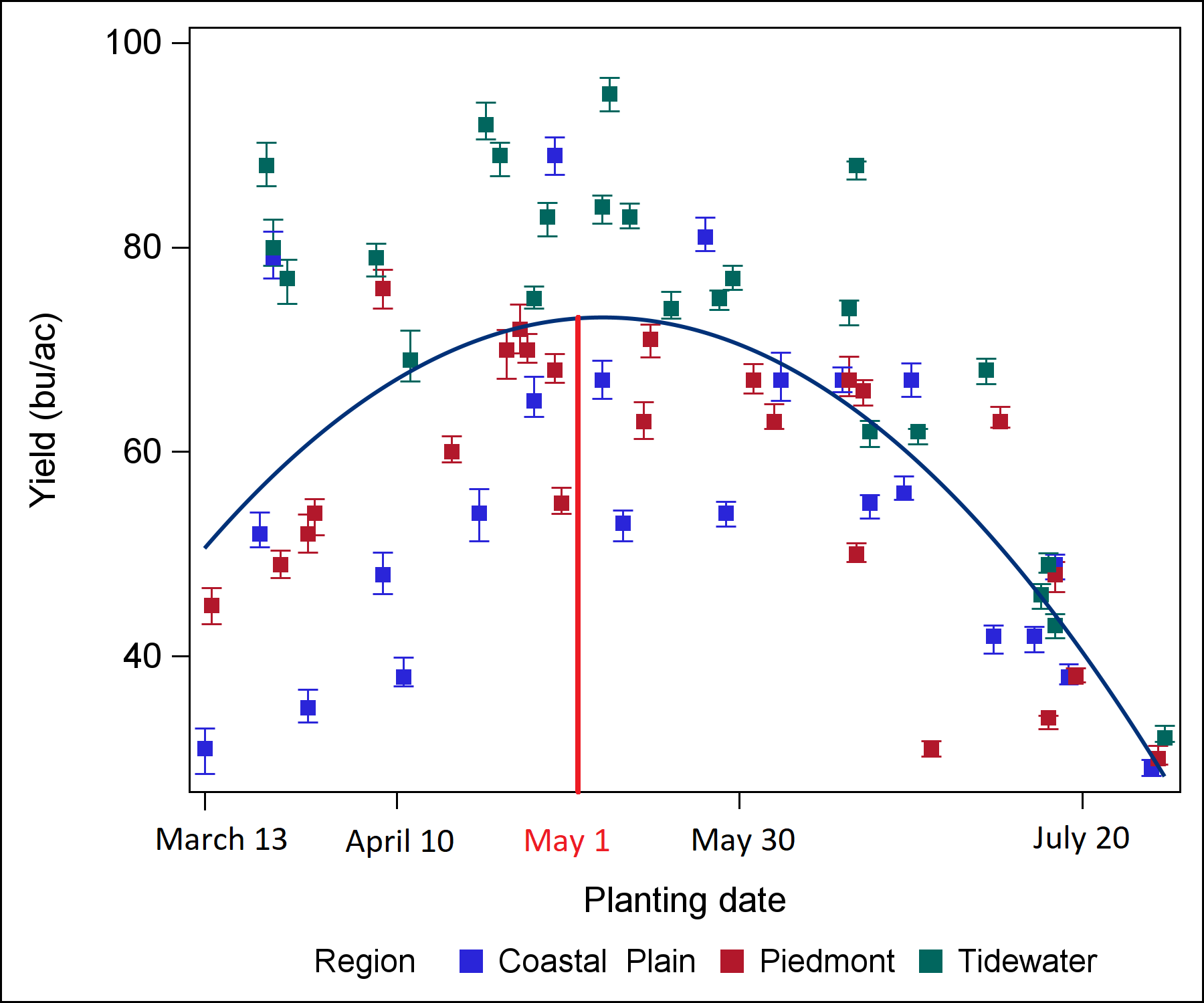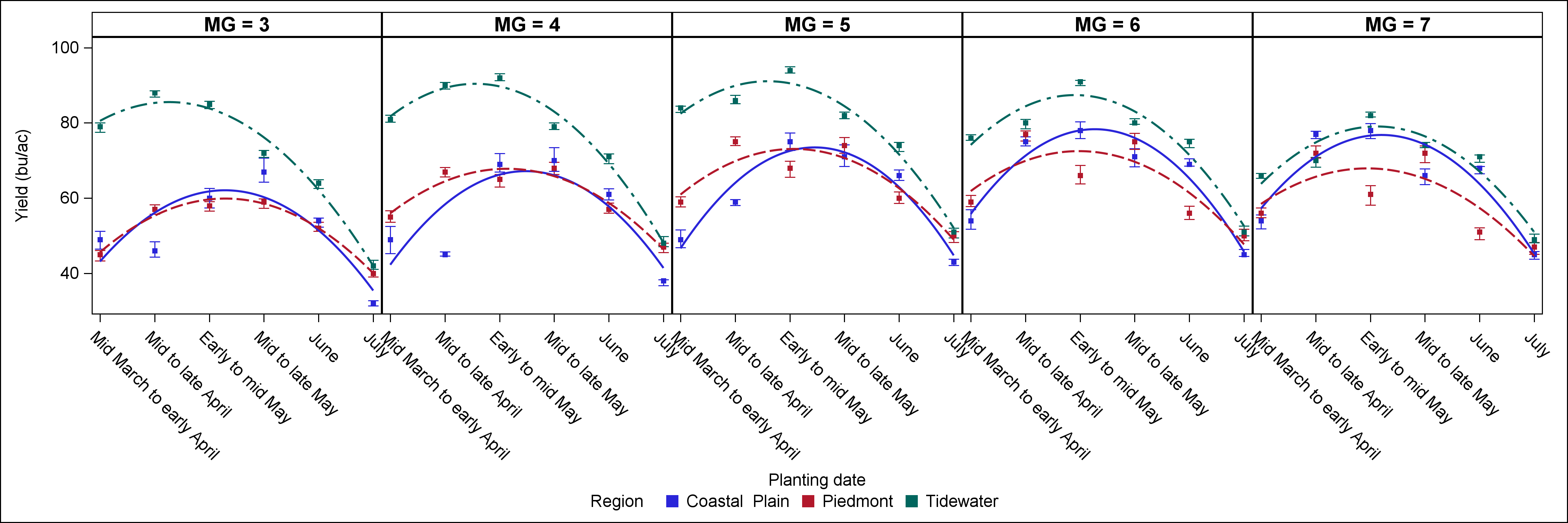Data-Driven Recommendations for NC Soybean Planting Date
go.ncsu.edu/readext?927859
en Español / em Português
El inglés es el idioma de control de esta página. En la medida en que haya algún conflicto entre la traducción al inglés y la traducción, el inglés prevalece.
Al hacer clic en el enlace de traducción se activa un servicio de traducción gratuito para convertir la página al español. Al igual que con cualquier traducción por Internet, la conversión no es sensible al contexto y puede que no traduzca el texto en su significado original. NC State Extension no garantiza la exactitud del texto traducido. Por favor, tenga en cuenta que algunas aplicaciones y/o servicios pueden no funcionar como se espera cuando se traducen.
Português
Inglês é o idioma de controle desta página. Na medida que haja algum conflito entre o texto original em Inglês e a tradução, o Inglês prevalece.
Ao clicar no link de tradução, um serviço gratuito de tradução será ativado para converter a página para o Português. Como em qualquer tradução pela internet, a conversão não é sensivel ao contexto e pode não ocorrer a tradução para o significado orginal. O serviço de Extensão da Carolina do Norte (NC State Extension) não garante a exatidão do texto traduzido. Por favor, observe que algumas funções ou serviços podem não funcionar como esperado após a tradução.
English
English is the controlling language of this page. To the extent there is any conflict between the English text and the translation, English controls.
Clicking on the translation link activates a free translation service to convert the page to Spanish. As with any Internet translation, the conversion is not context-sensitive and may not translate the text to its original meaning. NC State Extension does not guarantee the accuracy of the translated text. Please note that some applications and/or services may not function as expected when translated.
Collapse ▲The NC State Soybean Extension program has been investigating the best soybean planting date in applied research trials since 2019. We have now conducted research in 15 environments across the state capturing a range of production environments and climatic variability to drive planting date recommendations. We will emphasize the optimal planting date can vary by location in the state and production practices which is why we are using this dataset to develop a dynamic tool that will predict optimal planting date and other production practices based on location in North Carolina. This tool will be released in 2024 once we collect our final year of plot data for this effort in 2023. Below we will discuss general planting date trends that have been consistent across the dataset.
Optimum Planting Period: If you look at the yield data generated across environments in North Carolina, the May 1 planting date maximized yield (Figure 1). However yield response to planting date was flat from about April 20-May 20, which would be our newly defined optimum planting period across the state (Figure 1). The historically defined optimum planting period was May 1-June 10, however we have new genetics and more aggressive management which has resulted in a shift of the optimum planting period earlier in the calendar year across the state.
It is evident that the trends for soybean yield response to planting date are largely the same across NC regions, however there is some geographical variation in how soybean yield responds to earlier planting dates that are worth discussion (Figure 2). In the NC Tidewater region, the yield penalty of planting before mid-April is less pronounced than it is with planting before mid-April in other NC regions, which means that based on this data growers can plant in the first two weeks of April in the Tidewater region without large yield penalty, especially when earlier maturing varieties are used.
Planting before mid-April: Outside of the Tidewater region, we have fairly consistently seen significant yield penalty of planting soybean before mid-April regardless of soybean maturity group used (Figure 2). These are the risks that we have observed to planting before mid-April in our small plots research trials: cool soils synergizing other issues that include early season insect pressure, intensified seedling disease issues, preemergence herbicide injury, lower soil/air temperature limiting vegetative growth before the soybeans move into reproductive development, and seed quality issues on the backend of the season particularly when an early maturing variety is planted before mid-April. The 2023 RMA early replant coverage date is now April 1 for soybeans across North Carolina as our data has consistently demonstrated planting in the first half of April is not any risker from a yield perspective that planting in mid-June, however based on our data generated since 2019 we would caution growers planting in the first two weeks of April outside of the Tidewater region for the risks articulated above.
Planting past mid-May: Our data consistently shows yield declines when planting date is delayed past the third week of May (Figure 1). In the past 5 years our soybean double crop acres have ranged from 15-35% of our total soybean acres (USDA-NASS). The 5-year planting progress average for NC soybeans by May 22 was 43% (USDA-NASS). That means 34-50% of our full season soybeans are getting planted past the optimal planting period and considerable yield gains could be made from pushing soybean planting into the optimum period of April 20-May 20 on those acres.




